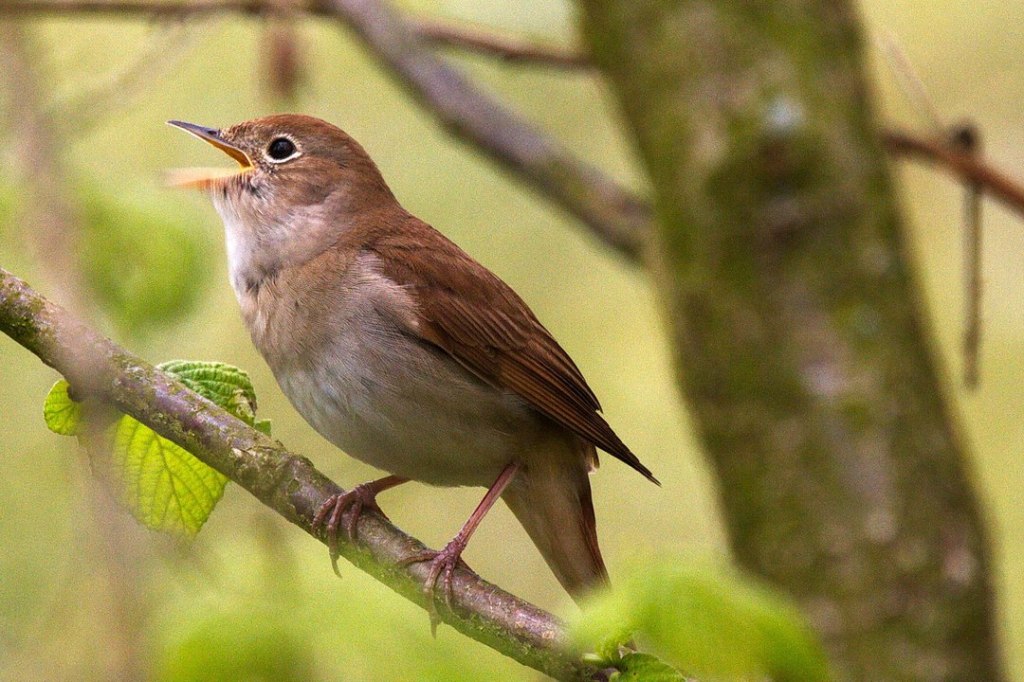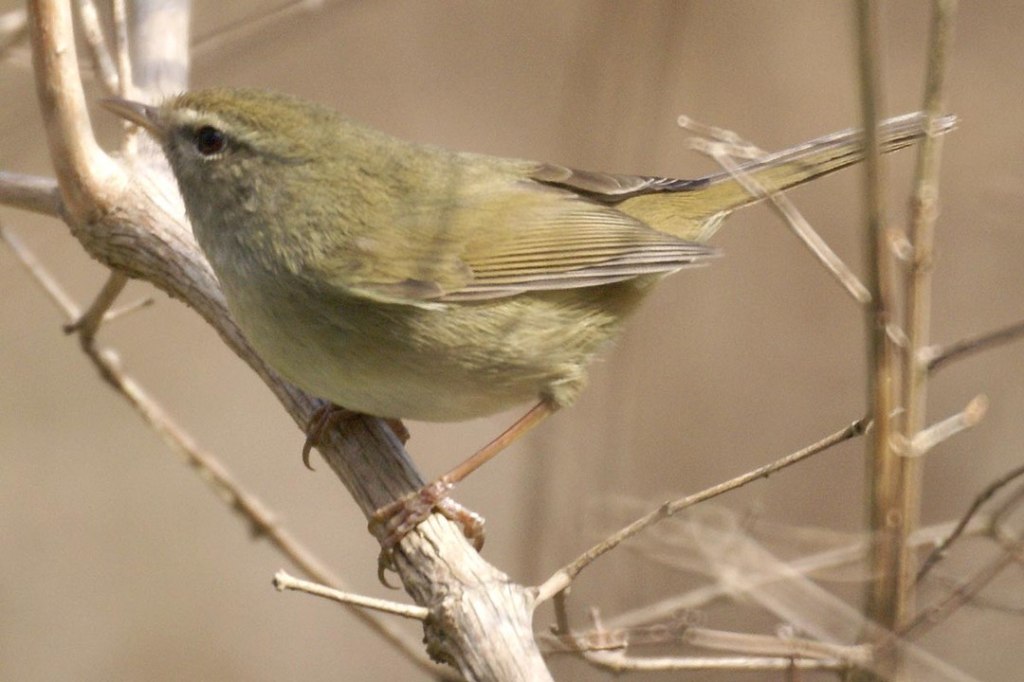We have entered the micro-season of “The Nightingale Sings”. This is the second micro-season of the mini-season First Spring. All the micro-seasons within First Spring are:
- Spring Winds Thaw the Ice (Feb 04 – Feb 08)
- The Nightingale Sings (Feb 09 – Feb 13)
- Fish Rise From the Ice (Feb 14 – Feb 18)
These seasons were established in 1685 by Japanese astronomer Shibukawa Shunkai and are specific to Japan. However, just because the calendar focuses on Japan doesn’t mean it isn’t applicable to others. No matter where you live you can use these seasons as a starting point for your personal exploration of the world around you.
To celebrate this season, we will learn about the common nightingale and the Japanese nightingales. We will then read seasonal haiku by Kerouac, Issa, Basho, and Dr. Gabi Greve.
The Nightingale
The common nightingale (Luscinia megarhynchos) is also called the rufous nightingale. Nightingales are small, relatively unassuming birds with brown-colored backs and wings, reddish tails, and a white underbelly. The males and females of this species look similar. The common nightingale is usually about 6 inches long. (1,2)
The nightingale is a member of the Passerine order of birds. They used to be classified as a member of the thrush, or Turdidae family. However, they are now considered to be a part of the Muscicapidae family. Birds in this family are also known as the Old World Flycatchers.(1)
Because of DNA analysis, a small group of birds moved from the Turdidae family to the Muscicapidae family.(1) This group is also known as Chats or chat-thrushes. Birds in this group are ground-feeding insectivores. Other birds, besides the nightingale, that are part of the Chat are the Golden bush robin (Tarsiger chrysaeus) and the Angola cave chat (Xenocopsychus ansorgei).(3)
The nightingales are migratory birds that spend their summers in Europe and parts of Russia and travel south to Africa for the winter. Nightingales are not naturally found in the Americas and are not common in Japan
The Japanese Nightingale
There are two other species, that are not Luscinia megarhynchos, that are found in Japan and referred to as nightingales.
Japanese bush warbler (Horornis diphone) is about the same size as the common nightingale and is a member of the Cettiidae family. The Japanese bush warbler is olive-brown with a paler underbelly. This bird is a year-round resident of Japan and its breeding song signifies spring is on its way. Because of its spring song, the Japanese bush warbler was known as the Japanese nightingale. This is not common anymore.
The red-billed leiothrix (Leiothrix lutea) is also called the Japanese nightingale, Pekin nightingale, or the Pekin robin. This bird is a member of the Leiothrichidae family and is native to southern China. The red-billed leiothrix is much more colorful than the common nightingales. Their backs are still olive green, but they have a bright yellow-orange throat with a yellow chin The adults also have bright red bills and a dull yellow ring around their eyes.



The Songs of the Nightingales
The common nightingale got its name because of the melodious songs it sings after dark. Only the male nightingale sings and it is suspected that they sing at night to attract migrating females as they fly overhead.
The common nightingale is said to be “able to produce over 1000 different sounds, compared with just 340 by skylarks and about 100 by blackbirds. This is because the part of the brain responsible for creating sound is bigger in nightingales than in most other birds.”(6)
The following nightingale song was recorded in 1961 in the Teign Valley, Devon, England
In comparison, here is the song of the Japanese bush warbler (Horornis diphone). This audio file also has a crow in the background.
Finally, to hear the song of the red-billed leiothrix (Leiothrix lutea), follow this link to The Cornell Lab of Ornithology’s Macaulay Library for hundreds of recordings and photos.
Seasonal Haiku
The World Kigo Database tells us that Uguisu or Japanese Bush Warbler/Nightingale has the potential to be a kigo for any season. However, because the uguisu is known for its constant singing in the spring, it is often considered a spring kigo. Other variations of the uguisu that are spring kigo are “first nightingale” (hatsu uguisu), “first call of the nightingale”, (uguisu no hatsune) and “nightingale flute” (uguisu bue).(6)
Besides the nightingale, there are many other birds associated with spring. Dr. Gabi Greve explains, “We have some nice kigo about these early birds of spring, twittering happily in the bamboo groves and rushes. It could be any kinds of birds, including turtledove and cuckoo.”(7)
With this in mind, let’s read some haiku about bird songs.
Jack Kerouac
Birds singing in the dark -Rainy dawn.
Listening to birds using different voices, losing My perspective of History
Bach through an open dawn window– the birds are silent
Issa
birdsong in bamboo grass-- too shy for the fence (translated by David G. Lanoue)
even in the mountains warblers and humans cry out, u-gu-i-su! (translated by Chris Drake)
singing practice every morning with the warbler (translated by Chris Drake)
Gabi Greve
early morning - the healing power of birdsong
Basho
Your song caresses the depths of loneliness, high mountain bird (translated by Sam Hamill)
Haiku Invitation
This week’s haiku invitation is to write a haiku or senryu that references spring bird song.
Here is a quick one from this morning:
chick-a-dee-dee-dee from a snow covered branch– not spring yet!
Share your haiku in the comments below, or post on your own page and link back to this post. I can’t wait to read what you write!
Looking for more bird-inspired haiku? Check out this week’s Haiku Dialogue for the Haiku Foundation with guest editor guest Nancy Brady. The theme is Avian Adventures.
Resources:
- “Nightingale”; BirdFacts.com
- “Common Nightingale”; Wikipedia
- Chat (bird); Wikipedia
- “Japanese Bush Warbler”; Wikipedia
- “Red-billed leiothrix’; Wikipedia
- “10 amazing facts about nightingales and the best places to see them”; BBC, Discover Wildlife
- “Nightingale (uguisu); World Kigo Database
- “Birds of Spring and START SAIJIKI”; World Kigo Database
Jack Kerouac’s haiku were retrieved from Jack Kerouac’s Book of Haikus. Issa’s, and Dr, Gabi Greve’s haiku were retrieved from World Kigo Database “Nightingale” and “Birds of Spring”. Basho’s haiku was retrieved from Matsuo Bashō’s haiku poems in romanized Japanese with English translations


Wow, your chick-a-dee haiku really works this morning, as does the song of the Japanese bush-warbler which fired up my indoor cats! The song of the European nightingale, which I’ve heard live in my foreign travels, is simply incredible. Thank you for another interesting post.
Hi Walt, Thanks for comment! I had that same issue with our cat when I was testing the audio links for the post. The dog, however, didn’t see to care. So glad that you enjoyed this one!
Mark, I’ve not heard a Nightingale for many years, certainly not here in NI. When we lived in the south of England and walked the Chiltern Hills we would have heard them then! A wonderful sound but remember the sound in summer, not spring!
Hi Ashley, thanks for the comment and sharing your memories! I don’t think I have ever heard a nightingale sing, but a bet it must be pretty amazing given their vocal range. In your memory, did the nightingales start signing about now?
Mark, it’s over 20 years since we lived there! I would say that February is still too early for them, perhaps April in southern parts! [From here, London and surrounding places are probably 300 miles further south (3 degrees latitude) and about 6 degrees further east. The S.E. of England has a much more continental feel to its climate, warmer, dryer summers! Here in NI, part of the island of Ireland, the Atlantic has a big influence on our weather, cooler and wetter]. The best we get here is the song of the Blackbird (Turdus merula) and the wonderful Song Thrush (Turdus philomelos), my favourite. Both have been singing recently; lovely. 🙋♂️
Hi Ashley, thanks for that detailed response! I am fascinated by the differences in climate based on the location. So I appreciate your attention to the latitude and the the impact of the water on the weather!
Wow.love the bird songs, readings, and the lovely haikus💚🙏🌹In my country Bird of Paradise is our National Symbol.. Below is a Bird of Paradise haiku. They dance and spread their beautiful plumage to attract females during courtships.
Bird of paradise
Beauty of Eden display
Dancing like star
Hi Joanna, I had to look up a bird of paradise bird. I couldn’t recall what they looked like from memory. What an amazing bird! Thank you so much for sharing your haiku!
You are welcome Mark
I so enjoyed this springtime celebration, Mark, with the moving poetry and enchanting birdsongs. I liked every poem, but was especially drawn to the last one by Basho. Also enjoyed the bird information. We do not have nightingales in the contiguous U.S., as you pointed out, but I have had the pleasure of seeing the red-billed leiothrix in Hawaii. Warm thanks and happy spring to you.
Hi Jet, Interesting to hear that you have seen the red-billed leiothrix in Hawaii. In my research, I came across a few mentions that there are conservation concerns around the bird. I wonder if that is a global concern? Hmmm, more research is needed! Thanks again for the comment and I hope all is well!
Mark,
I looked up songbirds… I have Mockingbirds, not nightingales. Close? Anyway I did some ‘Pairs’ Feb 10 here 🙂
Have a great weekend ~Jules
Hi Jules, Great job on the pairs! Where I live we also have the northern mockingbird, but no nightingales. The migration maps say that they are year round residents, although I am not sure I have ever heard one in the winter. I may need to go out and see if I can find one!
I also think I have ‘catbirds’ –
As nouns the difference between mockingbird and catbird is that mockingbird is a long-tailed american songbird of the mimidae family, noted for its ability to mimic calls of other birds while catbird is either of two species of american mockingbird relatives, the grey catbird,.
nightingale
sings in the darkness
a heart opens
or perhaps it’s better as a monoku:
nightingale sings in the darkness a heart opens
This one is better read aloud because it can be said many ways just as the nightingale’s song has such variety.
I was so grateful you included the audio clips, Mark. I was amazed by the versatility of this little bird. Yet another reason to move to Europe!
Gorgeous haiku, and I think it works both ways (haiku or monoku), Eavonka.
Thank you, Nancy!
I am delighted that it is so versatile. I surprised myself.
Hi Eavonka, what a wonderful haiku/monoku. I really like that you presented both options so that we can read them and see how they land! I am glad that you enjoyed the audio. I thought it would be a good addition. Thanks again for sharing your great work!
A couple of haiku with spring birdsong:
bare trees…
the trill
of red-winged blackbirds
~Nancy Brady, 2023
morning meditation
she relaxes
into the wren’s song
~Nancy Brady, 2023
http://www.nbsmithblog.wordpress.com
I knew you would knock these out of the park, Nan!
Writing haiku is my morning meditation. 😉
Eavonka,
I cheated. I modified a few haiku from the past. I am more like you, haiku writing is more my kind of meditation. I’ve done the other, but tend to think too much when I should be otherwise meditating.
Hi Nan and Eavonka, I find there is something quite enjoyable about haiku the references meditation, or perhaps highlight the challenges of meditation. I think it might be because, as long time meditator, I often drift off into thought and these haiku validate my experiences.
These are lovely, Nancy. I love the sound of red-winged blackbirds in early spring. They are not very nice when their fledglings are about, however. I’ve been strafed/buzzed a couple times.
Thanks, Mary Jo. I, too, like the trilling of red-winged blackbirds. Fortunately, ours tend to nest away from our home so I have never experienced strafing from them. On the other hand, wrens come later in the spring; they have a lovely song, but they buzz angrily if you come near their nests (they make both fake and real nests). In our small yard, with a garden toward the back, they buzz at us regularly.
I like your robin haiku. We’ve already had a few winter robins, but not much songs from them. ~nan
Hi Nan, these are wonderful. I really like the morning meditation! It captures the potential of spring/summer morning. Thanks so much for sharing!
Thank you, Mark. Your blogs inspire me to write more haiku. I changed up the fragment and I think it really improved the haiku. If you use the same phrase, but change out the fragment, is it the same haiku or a different one? Inquiring minds want to know.
It seems like a new haiku to me! Its the evolution of work. Maybe like the difference between a 2021 car and a 2023 car. Still about the same car, but it had grown with the times. Or maybe that is a horrible analogy.
Thanks for weighing in, Mark. I’ve always wondered, but never thought to ask other haiku poet. It isn’t as if I don’t know any.
I chose the simple and common robin, because well, you know. They don’t really sing or warble, but they are the bird most associated with early spring. 🙂
Harbinger robin
chirrups before our sunrise
pecks through frozen mud
Depending on the weather – sometimes our Robins are here all year long. I do enjoy them when they fill the yard puffing and strutting. I haven’t seen any robins yet. I have Cardinals, wrens and woodpeckers all year round. But then I also see heron, geese, ducks, falcon, and other birdies – I feed them 🙂
Hi Mary Jo, A robin is a solid choice for a spring haiku! And highlighting their morning song is very wise. Hopefully, I will be able to see robins again soon! We just need a couple of snow to melt first!
Thank you, Mark! Soon, very soon. 🙂
Sometimes the Robins stay all year round – not this year – too cold. I’ve been able to watch some robins nest in my hedges a few times. 😀
Looking forward for the robins to return in our area.
The robins are a seasonal timepiece for sure!
I haven’t seen any yet. But on a walk this afternoon I saw blooming snowdrops!
How lovely!
Thursday at the lawn area of our bowling place there were dozens of Robins!!! But last night it got to below freezing – supposedly it is 50F now… but I’m not sure!
We’re on the cusp of Spring for sure!
Warm enough for a stroll before lunch and I saw some small blooming grape Hyacinth under a bush!
Hi Mark. Another great challenge to respond to. Love your ‘chick-a-dee-dee-dee’ rendition.
Have a great day.
Reblogged this on Art, Music, Photography, Poetry and Quotations.
Hi Mark. Here is my offering to this week’s prompt – ‘Spring Birdsong’
Happy Smiles Day Everyone.
Wonderful haiku and it helped me learn something new! Have a good weekend and thanks for sharing.
love it Mark.. My cat is looking for them. Can I use your pics ever?
love your haikus as well. .. I love seeing how small they are and all of the information ❣️
Hi Cindy, The cats do seem to enjoy the recorded bird songs! My cat and dog both perked up as I was testing the links. Many of the photos I use for the post come from Wikimedia and listed under the creative commons licenses. A CC license is used when an author wants to give other people the right to share, use, and build upon a work that the author has created. There are different version of CC licenses and I find photos that are listed as “free to use and adapt”. I always put a hyperlink in to the original source so you can go back to the source.
Glad you enjoyed the haiku! Have a great weekend!
It’s so sweet to watch them on the prowl when they hear their voices. That’s so cute. oh, got it and thanks so much for all of that information. Thanks for letting me know about the hyperlink. I love all of your haikus and wonderful information. I will and you do the same!
💞
Here’s mine: https://oddsends707138946.wordpress.com/2023/02/12/ode-to-joy-by-britta-benson/
Thanks for the challenge!
Hi Britta, Thanks so much for writing and linking up. And thanks for the fun haiku for today!
Beautiful bird and beautiful song thanks Mark ❤
Thanks so much for writing a wonderful haiku and joining the conversation!
You are welcome ❤
Don’t know if I would call it song but here’s one:
wagtail chatter
the teens fall silent
in the shade
Hi Sean, Thanks for visiting and adding to the conversation! And, yes, I think that totally counts. I mean I bet a wagtails chatter is still more melodic than any of my singing!! Thanks again for stopping by.
wagtail chatter
the teens fall silent
in the shade
wagtail chatter
the teens fall silent
in the shade
Not sure if it’s song though 🙂
I wrote a bird haiku recently to go with my cockerel painting:
Time to get up but
the arms of sleep surround me
cock-a-doodle-doo!
🙂
Hi Sunra, This is wonderful! Such a fun haiku. Thanks for sharing this!
Ha ha! Thank you!